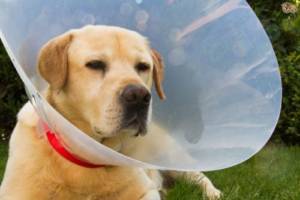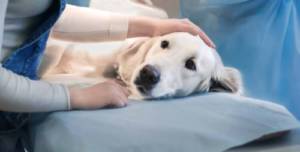If you have a female dog, you must have heard about spaying from the vet or others around you. Spaying is the process of removing the womb from a female dog or the removal of ovaries and uterus. Spaying is a socially responsible decision. It offers a host of lifelong benefits for your female dog, including prevention from infection and decreased irritability. It even reduces the risk of breast cancer by half.
But spaying your female dog requires delicate and concerned care for the dog over a period of time after surgery. Just like a woman after uterus surgery, a female dog needs time to heal up. There are many restrictions that your dog would face immediately after the surgery. While a female human is intelligent enough to protect herself, her dog may expose her wound and aggravate it. So you need to do the following to care for her just right.
What to do in order to Care for Female Dog with Wound?
-
Don’t let her play for at least a fortnight –
Female dogs are very energetic, and if you let her free outside to play with other dogs, they can open up the wound. It can lead to a longer time in healing and even post-surgery complications. It’s advised not to let your dog exercise or play for at least 10 to 14 days post-surgery. This is because the wound heals up considerably in this period of time. You still perhaps want to let her not run wildly in bushes and with other dogs but play under control.
-
Get her a Cone Dog Collar –
Dogs tend to lick their wounds which can lead to infection. You can’t teach your dog not to lick her wound, but you can keep her safe to wear a cone collar. The collar prevents her tongue from reaching the wounds.

-
Keep your dog on a leash –
You can take her for a short walk as she becomes restless after 4 to 5 days. But dogs get attracted by their surroundings and want to chase things they see on the park or road. Don’t walk for more than 5 minutes with her. It would be best if you supervised her and not let her play roughly in this period.
How long will my Dog be in Pain after Spaying?
The vet has to make a large incision to remove the ovaries while spaying. The extended cut in skin and muscle layers makes it a painful recovery time for your dog. But with pain relief medications and proper care, you can fasten the healing process and save your dog from excessive pain.
Dogs are given an injection that relieves them from any pain during the surgery. The effects of the injection last around 8 to 12 hours. Your dog might feel some pain from 10 to 14 days after the surgery. The vet will give you medication that will help subside the pain during the early days of recovery.
Symptoms and Preventions after the Surgery:
-
Dog becoming Hyperactive –
Your dog may feel some symptoms in the aftermath of the surgery, and that is entirely okay. While some dogs feel a little pain after surgery, others may feel a stronger sensation. If your dog becomes restless and tries to run around, she may further damage her incision. You would want to keep her calm by restricting her activity and keeping her at home tied with a collar. Try to be around her, so she feels secure.
-
Counter the effects of Anesthesia –
Your dog might vomit or urinate during sleep. This is normal, and you don’t need to panic as it is the effect of Anesthesia. Anesthesia also makes dogs sleep for long hours and become rather weak. Place a puppy pad to save her from irritation and infection due to urination while she’s sleeping. Sleeping also quickens recovery.

-
Loss of coordination –
Your dog may fall while walking or running in the aftermath of the surgery. Try to pick her up while taking her to the vet. She shouldn’t jump and fall, which may tear her stitches and result in bleeding. So try to keep her under observation, pick her up to the couch and restrict her movement. Proper rest is the key.
-
Check the incision twice or thrice every day –
Check for signs of any infection, tears or bleeding. You don’t want to get late in identifying the problem and aggravate the injury or infection. Call the vet instantly when you spot these symptoms.
What age should your dog be spayed?
Females dogs come to a stage in their reproductive cycle when they want to mate with other male dogs. They become receptive to male dogs as the estrogen levels increase twice a year. This stage is called heat. A female dog usually attains heat only after six months of age and some dogs may get as late as 24 months.
The ideal stage to spay your female dog is before their first heat. This is usually around eight months of age although you can opt for spaying even after your dog has attained her first heat. The risks of spaying at a later age is that your dog may still be receptive to males even after spaying at a later age. Vets can even spay dogs as young as two months old. It’s best to consult your vet before her first heat to know the best time for spaying for her.
Antibiotics after spaying dog:
Many of you might be surprised to know that antibiotics aren’t needed before or during spaying surgery. Anaesthesia is used to prevent the dog from feeling any pain during surgery. But antibiotics plan an important role in cases of infection post-operation.
While it is normal for the dog to bleed a little from the wound in the first two days of surgery, prolonged bleeding, swelling or odour indicates infection. If your pet experiences excessive pain after two days, you should immediately contact your vet.
To heal the infection and stop bacteria from developing, the vet would prescribe your dog a round of antibiotics like Cephalexin or Enrofloxacin. It’s vital to complete the round of antibiotics without missing any dose duly. Antibiotics are life-saving medicines, and you don’t want your pet’s body to get immune to them.
Don’t stop antibiotics even if the wound heals considerably. Contact your vet if you see any further complications. Don’t forget to go to the vet for reassessment after completion of the round of antibiotics.
Source:
https://dogtime.com/dog-health/general/42-spaying-your-female
